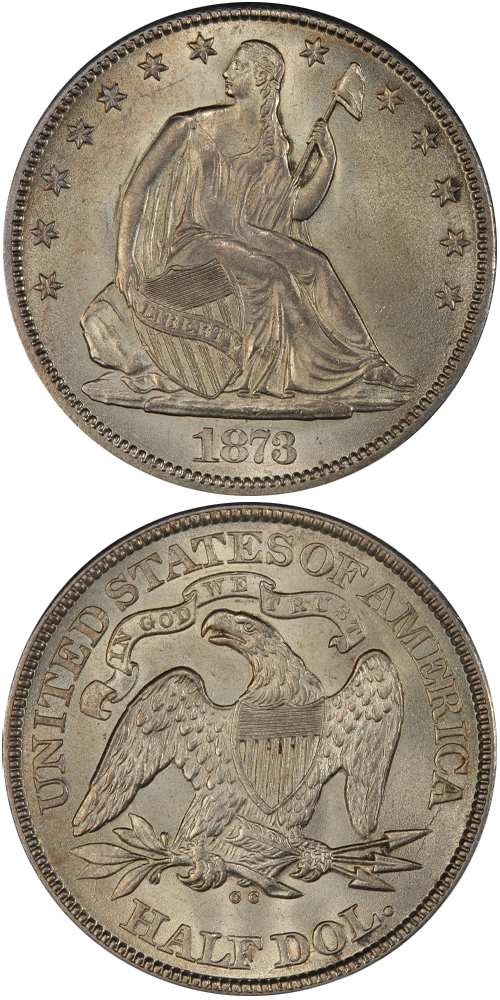1873-CC Liberty Seated Half Dollar
No Arrows
Jeff Ambio: Two die marriages are known for the 1873-CC No Arrows half dollar, sharing the same reverse. WB-1, represented here, is most easily distinguished from WB-2 by a concentration of scattered die lines in the drapery around Liberty's left (facing) hand. The reverse exhibits a small CC mintmark and has two tiny die lumps within the feathers in the eagle's left (facing) wing.
Rusty Goe: The Carson City Mint ended 1872 with a flourish of production totaling $710,000 worth in December. Superintendent Rice and his crew looked forward to 1873 with much optimism. The news that a mining man, John Percival Jones, would soon take his seat as one of Nevada's representatives in the U.S. Senate sounded promising to a state so dependent on mineral resources and the business of turning that bullion into coins.
The coiner struck 12,000 half dollars, without arrowheads, on February 11, and another 14,000 on the 25th, to add to the 22,000 pieces he had minted in January.
The big news in February of course was the passage of the Coinage Act. Carson Mint employees, as well as everyone else in northwestern Nevada, awaited news of any kind about how that legislation would affect their courses.
The Gold Hill News announced on March 1, 1873, that a fresh, and potentially abundant, discovery of ore had been made right in the heart of Virginia City. This launched the "Big Bonanza" period on the Comstock Lode, as the firm led by Mackay, Fair, Flood, and O'Brien would catapult the findings in their Consolidated Virginia Mine to legendary levels. The Bonanza Firm formed another company, called California, later in 1873, which together with the Con. Virginia, would reap millions of dollars for the fortunate few lucky enough to cash in.
Coiner Noteware delivered the final 74,500 "old style" half dollars in March, bringing the total of 1873-CC No Arrows fifty-cent pieces to 122,500, Curiously, the Carson Mint produced 88,500 of those soon-to-be obsolete halves after the passage of the Coinage Act on February 12.
Q. David Bowers: In 1873 half dollars were made with and without arrows in an approximate proportion of one of the first to two of the second. The implementation of the Coinage Act of February 12, 1873 raised the weight very slightly. After that point arrowheads were added alongside the date and the second variety was struck to the extent of 214,560 pieces.
Today approximately 10 to 15 are believed to exist in Mint State, a few of these at the Gem level. However, most are tightly held and often a significant span of time can pass between purchase opportunities at auction.
The example to the left was sold by Stack's Bowers Galleries in the August 2012 Battle Born Collection of Carson City Coinage, where it realized $41,125.






